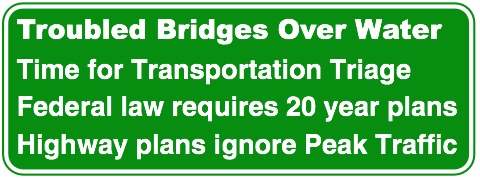Vermont
| Trillion Dollar Highway Plans = Multiple Bypass Surgery a state by state list |
|
| High Priority Corridors specified by Congress in 1991, 1995, 1998, 2005, 2012 |
|
| NAFTA Superhighways | |
| Corridors of the Future | |
| J. Edgar Hoover Parkway: transportation surveillance, mileage taxes, RFID & video tolling |
|
| Paving Appalachia:
Corridor A to X in AL, GA, MD, MS, NC, NY, OH, PA, SC, TN, VA, WV |
|
| Alabama | Nebraska |
| Alaska | Nevada |
| Arizona | New Hampshire |
| Arkansas | New Jersey |
| California | New Mexico |
| Colorado | New York |
| Connecticut | North Carolina |
| Delaware | North Dakota |
| Florida | Ohio |
| Georgia | Oklahoma |
| Hawai'i | Oregon |
| Idaho | Pennsylvania |
| Illinois | Rhode Island |
| Indiana | South Carolina |
| Iowa | South Dakota |
| Kansas | Tennessee |
| Kentucky | Texas |
| Louisiana | Utah |
| Maine | Vermont |
| Maryland | Virginia |
| Massachusetts | Washington |
| Michigan | Washington, D.C. |
| Minnesota | West Virginia |
| Mississippi | Wisconsin |
| Missouri | Wyoming |
| Montana | |
High Priority Corridor 50: East-West Corridor
New York: US 11 -
Watertown to Rouses Point
Vermont: US 2 - Burlington, Montpelier, St. Johnsbury
New Hampshire: US 2
Maine: US 2, I-395 (Bangor), Route 9 to Calais (Canadian border)
Bennington Bypass
segment to New York built, northeast segment under construction
Burlington
Vermont Circumferential Highway - Interstate 289
Initial segment built about two decades ago, connectors to I-89 unbuilt due to environmental controversy. Gov. Dean got the George W Bush administration to remove it from normal environmental reviews. This is the main freeway fight in Vermont.
www.circeis.org - Circ is risen from the dead
"The Final Environmental Impact Statement was completed in July 2010 with a Record of Decision on a preferred alternative issued in May 2011."
Record of Decision only included the southern part of 289 and the highway's design has been scaled back to an expressway, not a highway built to interstate standards. Converting a new traffic light controlled intersection to a grade separated interchange could be completed after the initial segment is built.
www.ccrpcvt.org/corridors/circ-alternatives-task-force/circ-history/
Chittenden County Regional Planning Commission page on Circ alternatives and history
www.vtsprawl.org/News/breaking/circ-stopped.htm
CIRCUMFERENTIAL HIGHWAY STOPPED BY JUDGE
VFOS Sees Opportunity for Exploring Highway Alternatives
The Vermont Forum on Sprawl hailed the federal district court’s May 10th, 2004 decision to halt construction of the Circumferential Highway as an opportunity for Vermonters to explore alternatives to this massive highway project. Judge William Sessions cited the failure of the proponents to adequate assess the induced and cumulative growth impacts of the highway within their Environmental Impact Statement (1986) and subsequent Environmental Assessment (2003).Excerpts from the May 10th Ruling of Judge Sessions
"…the 1986 FEIS included no discussion whatsoever of cumulative impacts. It contained a sketchy acknowledgment of indirect impacts with regard to agricultural lands with no analysis. These deficiencies cause the 1986 FEIS to fail to meet the standards for an adequate EIS for purposes of adoption by FHWA."
"Induced growth consists not only of growth that would not have occurred absent the project, but of relocated or redirected growth due to changes in accessability. The 1986 FEIS assumed that relocated development would occur generally in the vicinity of the new intersections and in high density zoning districts… There was no discussion of the potential detrimental impact upon areas from which population and resources would be drained."
"In its induced growth analysis, FHWA did not consider factors such as the detrimental social and economic impact of draining jobs and population from the region's cities: Burlington, South Burlington, Essex Junction and Winooski. In response to comments pointing out this omission, FHWA noted that growth rates in the urban core cities have been declining for thirty years and are predicted to continue."
"... The Court cannot conclude that this constitutes a "hard look" at the effects of relocated growth in a region. The 1986 FEIS did not discuss any development pressure on towns not directly adjacent to the CCCH. In fact, these towns aren't even on the maps included in the FEIS. The FREA's induced growth study summarizes that while the Adjacent Towns25 and Outer Towns26 will experience small increases in accessibility, their growth potential is affected by construction of the CCCH:
"[h]owever, planning and zoning within some of these towns is less developed, and growth pressures within some of these towns may result in uneven growth patterns."
www.vnrc.org/sustainable-communities/hot-issues/stop-the-circ-highway/
Vermont Natural Resources Council page against the Circ
In 2002, Governor Howard Dean's administration made a deal with the Bush administration to ensure that the long proposed, controversial, expensive, destructive Interstate Bypass of Burlington (I-289) would be a top national transportation priority, bypassing not only the downtown business district but also long standing environmental laws (most of them signed by Richard Nixon). Dean's administration also built a new bypass around the city of Bennington in the last couple years.
A Federal Highway Administration press release on the "streamlining" of environmental review is at www.dot.gov/affairs/dot01503.htm
from the Bush administration's list of priority highway projects for "streamlined" environmental review:
www.fhwa.dot.gov/stewardshipeo/pplist.htm
U.S. Department of Transportation
Environmental Stewardship and Transportation Infrastructure Project Reviews
Department of Transportation Priority Project ListChittenden Circumferential Highway - Vermont. This project provides for the construction of a new, four-lane, divided, limited access highway approximately 16.7 miles long in Chittenden County, Vermont. This project will intend to alleviate future congestion, address safety concerns, and assist local roads to function within their operational capabilities.
www.vtst.org/index.html - Vermonters for Sound Transportation
group opposing Interstate 289, the Chittenden Circumferential Highway (the Outer Beltway bypass of Burlington, Vermont's largest city). It would decimate rare forest ecosystems, be extremely expensive, fuel sprawl at the outer edge of the Burlington metro area (at the expense of its downtown) and increase the waste of non-renewable petroleum.
[update: this website is not on line any more]
Dean's deal with President Bush to exempt Burlington Beltway from environmental laws
www.stopthecirc.com/news.html [not on line any more]
November 11, 2002:
Circ Highway on List of Transportation Projects for Expedited Environmental Review
As has been reported by the Vermont press, on October 31st the Circ Highway was named as one of seven transportation projects nationwide accorded special status for expedited environmental review pursuant to an Executive Order signed by President Bush on September 18th.
The Administration's October 31st "treat" coincidentally named projects in several states where close elections for Governor or for Congress were taking place.
We have been trying to determine what the practical consequences of this expedited review means. According to reports in the media, Governor-Elect Douglas appears to view this designation as a reward for his campaign, and as evidence that the federal government now supports getting the Circ built. A reading of the Executive Order, however, does not -- at least on its face -- appear to support this point-of-view. As the Executive Order states: "agencies shall to the maximum extent practicable expedite their reviews for relevant permits or other approvals, and take related actions as necessary, consistent with available resources and applicable laws, including those relating to safety, public health, and environmental protection."
Moreover, U.S. Transportation Secretary Norman Mineta did note in a press release (pdf file) announcing the seven projects selected, that despite the goal of cutting through "federal bureaucratic intertia" ... "we will not, however, sacrifice environmental standards."
StopTheCirc.com supports efforts to resolve environmental concerns about the Circ Highway as promptly as possible. If the Executive Order & designation of the Circ as a priority project have the effect of making available the needed funds to allow EPA, FHWA, and other agencies to conduct a prompt, but thorough, environmental review, then this designation will be quite beneficial. The sooner these questions are resolved, the better -- again, with the caveat that expedited review should not mean cursory review.








